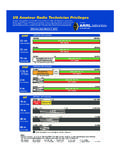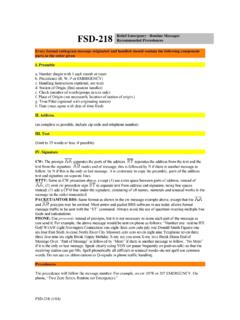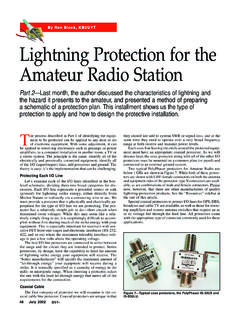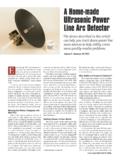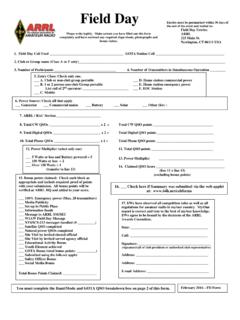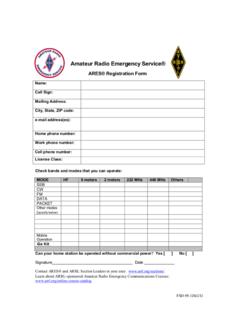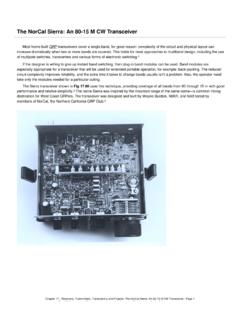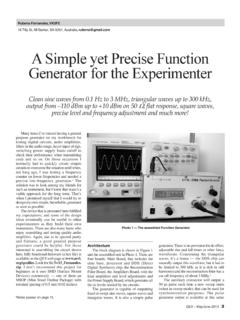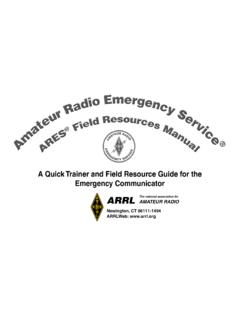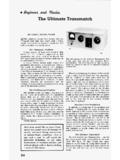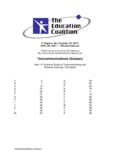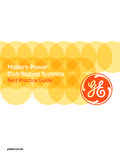Transcription of VoIP and Amateur Radio - American Radio Relay …
1 From February 2003 QST ARRL By Steve Ford, WB8 IMY Voice Over Internet Protocol, bet- ter known as voip , is not new. People have been enjoying voice communication over the Internet for years. What is new are the latest Ama-teur Radio applications of voip . Rather than relying on ionospheric propagation for long-distance communication, a growing number of hams are using the Internet in combination with VHF or UHF FM transceivers to span hundreds or thousands of miles. There are several flavors of Amateur voip in use today. Depending on how they are configured, these systems may involve repeater linking where two dis-tant repeater systems share signals with one another (Figure 1). Another applica-tion is so-called simplex linking where one or more users with handheld or mobile transceivers communicate directly with a base station (or node) that is linked to the Internet (Figure 2).
2 The one element that all Amateur voip systems have in common is that the Internet acts as the Relay between stations. The appeal of Amateur voip is easy to understand. Technician licensees without access to HF can use these voip systems to enjoy a kind of Internet-aided DXing, having conversations with other hams far beyond the range of their FM transceiv-ers. General and Amateur Extra hams without HF stations at home can also ben-efit from voip in the same manner. Let s take a brief look at a few of the current incarnations of Amateur Radio voip . EchoLink EchoLink was developed by Jonathan Taylor, K1 RFD, in early 2002. In an astonishingly short period of time, EchoLink has become one of the domi-nant Amateur Radio voip systems with more than 30,000 users worldwide.
3 The free EchoLink software for Windows can be downloaded at When you start the EchoLink soft-ware, your computer taps the Internet to Figure 1 Two FM repeaters linked via voip . Figure 2 A diagram of a voip simplex node. If a control operator is not physically present at the station location and the node is functioning with wireless remote control, the control link must operate above MHz. See the sidebar, Is It Legal? . connect to an EchoLink server. Before you can make your first connection to the network, your call sign must be verified with the information in the FCC database. This can take minutes or hours, depend-ing on the state of the system, but it helps reduce the chances of nonhams entering the EchoLink network.
4 Once you re validated (you only do this once), the rest is easy. The EchoLink server acts like a telephone switchboard in cyberspace. It maintains a directory of everyone who is connected at any mo-ment. After browsing the directory, you can request a connection between your computer and that of another Amateur . Here s where it becomes interesting. The ham on the EchoLink receiving end may be sitting in front of his computer with a headset and microphone. Or he may have his computer connected to a base Radio at his station that is acting as an RF Relay to a handheld transceiver or mobile rig. Or the destination station may be part of a repeater system. In any case, once the connection is established, any- voip and Amateur Radio An increasing number of amateurs are putting the Internet to work as a bridge for long-distance voice communication.
5 Discover what the Voice Over Internet Protocol buzz is all about! From February 2003 QST ARRL Is It Legal? By Brennan Price, N4QX and ARRL General Counsel Chris Imlay, W3KD What Part 97 regulations govern voip -assisted Amateur Radio ? All of them or none of them, depending on whether you re asking about the voip -assisted or the Amateur Radio part of voip -assisted Amateur Radio . Many callers to the ARRL s Regulatory Information Branch over the last few years have focused on the novelty of the Internet when asking questions about the legal uses of certain systems. Such focus is misdirected. Part 97 does not regulate systems; it regulates stations. The Commission doesn t care what a ham has feeding his or her station; it cares that the station not the Internet, but the station is properly operated.
6 And all the rules that apply to any Amateur Radio station apply to one that retransmits audio fed to it by voip . Fine, so the Commission doesn t care about the voip part. Are there any particular rules a ham consid-ering such an operation should be aware of? The obvious answer is all of them, but we ll focus on a few that are easy to overlook, particularly for stand-alone, single channel operations. The main points to remember: All stations must be controlled. Only certain types of stations may be automatically controlled. Simplex voice operations do not qualify for automatic control. Any station that is remotely controlled via Radio must utilize an auxiliary station to execute said control, and auxiliary stations are restricted in frequency.
7 It s not as hard as it sounds. All you have to do is think about the type of station you re operating and how it s con-trolled. Let s look at a few examples. Two automatically controlled repeaters are linked via voip . Is this legal? Forget the voip linking, because that s the Internet. We re talking about two repeaters. Are repeaters legal? Yes. May repeaters be automatically controlled? Yes. There is no difference between this setup and two repeaters linked by another wired mechanism or by auxiliary stations. Assuming the two linked stations are repeaters, it is difficult to conceive of a situation where a voip link would not pass regulatory muster. The only caveat is that the voip software must prevent nonhams from accessing the repeaters from the Internet.
8 The key here is to avoid any configuration that would (1) permit a nonham to key an Amateur transmitter without the presence of a control operator, and (2) prevent the initiation by a nonham of a message via an Amateur Station without the presence of a control operator. Is it permitted to enable automatically controlled simplex nodes? No. Only certain types of Amateur Radio stations may be operated unattended, under automatic control. This means that there is no human control either at the station location or at a distance. These types of stations are space stations, repeaters, beacons, auxiliary stations and certain types of stations transmitting RTTY or data emissions. Simplex voip nodes are neither repeaters, beacons nor auxiliary stations.
9 Presumably, most are within 50 kilometers of the Earth s surface and are therefore not space stations. The voip technology implies a voice trans-mission, not RTTY or data. Therefore, none of the stations that qualify for automatic control describe a simplex voip node, and such a station must be locally or remotely controlled (as any Amateur Radio station is allowed to be). Locally or remotely controlled what does that mean? A simplex voip node may be locally controlled by an operator who is present at the node. Such a node may also be remotely controlled at some other point, with the opera-tor issuing commands via a wireline or Radio control link. If a Radio control link is used, it must utilize an auxiliary station, and such stations are restricted in frequency to MHz and above (with the exception of the CW, SSB and Amateur satellite portions of the 70-cm band).
10 It s this remotely con-trolled aspect that allows voip simplex nodes to operate legally as long as they are on the right bands. Let s consider seven scenarios: A control operator is stationed and active at the voip node on any frequency. This is a locally controlled station, not at all unlike a typical operation on FM simplex. This is legal. A control operator communicates with and controls a simplex voip node with a handheld, transmitting and listen-ing to the node on MHz. This is wireless remote control. Such control must be executed by an auxiliary station and MHz is an allowed frequency for such a station. This is legal. A control operator communicates with and controls a simplex voip node with a handheld, transmitting and listen-ing to the node on MHz.
